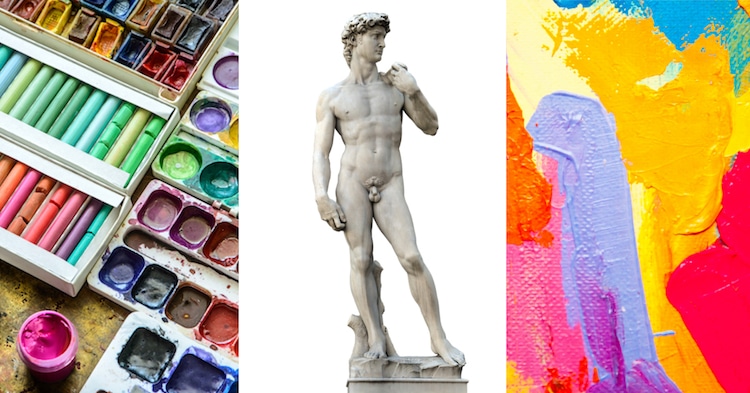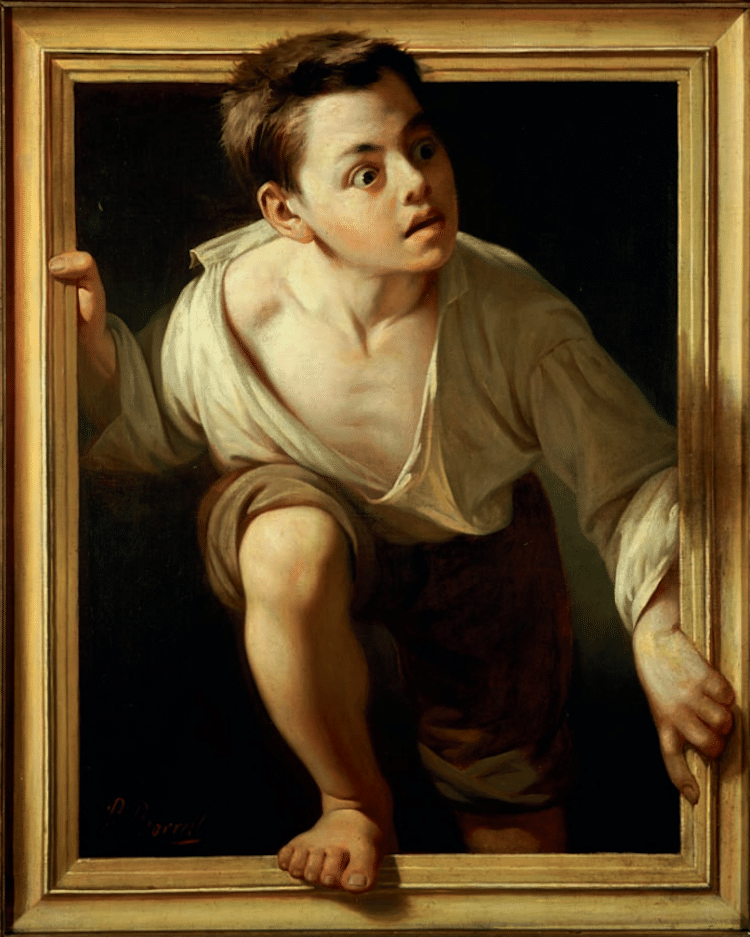Art History Term for Realistic Marble Statue in Painting

This post may contain affiliate links. If you brand a purchase, My Mod Met may earn an chapter commission. Delight read our disclosure for more info.
Like any creative field, art history has its ain language. While this reality can be overwhelming for aspiring art historians, having a handy glossary of art terms tin can make analyzing a work of art a lot less intimidating.
In this listing, y'all'll find 25 words that volition help you hash out art with ease. Ranging from general concepts, like brushwork and composition, to specific techniques, including chiaroscuroandtrompe l'oeil, this armory of art terms offers everything y'all demand to make the near out of your next museum visit.
Analyze art like a professional with this fine art history glossary.
Abstruse
Breaking abroad from the figurative representation of objects,abstruse art reimagines imagery equally a written report of the relationship between shape, form, color, and line. Abstraction occurs on a continuum, including the fractured-even so-recognizable forms of Cubism and the totally non-pictorial nature of Abstract Expressionism.
Aeriform Perspective
Every bit known every bit atmospheric perspective, this method for creating depth in ii-dimensional artworks focuses on the idea that the further an object is from the foreground, the lighter in tone and hue the color will be. By exaggerating the deviation in these tones, artists tin apply aerial perspective to create drama and establish the illusion of space on the picture aeroplane.
Assemblage
This artistic form or medium uses a mix of materials that create three-dimensional layers from a fixed based. The usage of different materials makes it similar to collage, but in a 3-dimensional form. Assemblage has its origins in Cubism and the work of artists like Man Ray and Vladimir Tatlin, who often used found objects in their artwork.
Avant-garde
The French term advanced literally translates to "advance baby-sit," but is used to describe artworks, movements, or artists that are experimental and forwards-thinking.
Biomorphic
Biomorphic artwork is art that, while remaining abstract, evokes the form and shape of natural and living organisms. The term was first used relating to art in the mid-1930s and has been connected with Surrealism and Cubism. Antoni Gaudí's Sagrada Familia is an example of architecture that has been characterized as biomorphic.
Brushwork
Brushwork refers to the way a painter applies paint to a surface. It is typically characterized by the size, texture, and precision of the strokes. For instance, brushstroke may be described as "tight" or "loose" depending on how visible they are to the naked eye.

Oil painting on canvas (Photo: Stock Photos from Sweetness Fine art/Shutterstock)
Chiaroscuro
Italian for "low-cal-dark," chiaroscuro is the use of potent contrasts between luminosity and shadow to attain a sense of volume and dimensionality. This unique technique was developed during the Italian Renaissance by Leonard da Vinci, the Bizarre period by Caravaggio, and the Dutch Golden Age by Rembrandt.
Composition
The composition of a work of art is the way in which its visual elements are arranged, peculiarly in human relationship to one another.
Conceptual
This 20th-century art form developed in the 1960s, when artists began to emphasize ideas and concepts over the finished product. Art that is conceptual breaks gratis from all the standard rules and tin have whatever course from sculpture and painting to happenings and performances.
Contour
As the outline of something, the contour is one of the edifice blocks of cartoon. Using different profile lines can dramatically modify the way an artwork appears and is almost axiomatic in line fine art.The Trip the light fantasticby Henri Matisse is just ane example of a work of fine art known for its distinct contours.
Contrapposto
In sculpture, contrapposto ("counterpose" in Italian) is an asymmetrical posture in which near of a figure's weight is distributed onto one foot. This results in a realistic stance, equally famously evident in Michelangelo'due southDavid statue.
Figurative
A work of art is considered figurative when its subject area thing is representational.
Foreground
The foreground of a piece of work of art is the part of the composition that is closest to the viewer. Information technology is typically discernible from the groundwork, which appears to be further away.
Foreshortening
Foreshortening is a technique in which an creative person distorts perspective to evoke an illusion of depth. Foreshortened subjects frequently appear to recede into the film plane.
Genre
A genre refers to a type of fine art (typically painting). Examples of genres include landscape and all the same life.
Iconography
Iconography refers to the subject affair, or images, used to convey meaning or communicate a message in a work of art.
Impasto
This Italian word for "mixture" refers to thick layers of paint used to create texture. While information technology was first used by Venetian painters during the Italian Renaissance, information technology actually took agree in the 19th century. Renowned landscape painter J.K.Due west. Turner used impasto to build layers of color and drama in his piece of work. Painters often use palette knives for this technique, which is meant to emphasize their talent in manipulating their chosen medium.
Medium
A medium is the fabric used to create art. Examples of mediums are watercolor paint, oil, pastel, marble, and charcoal.
Modern
Equally a movement, the term "modern" refers to art created between the onset of Impressionism and Pop Art, which ushered in contemporary fine art. On a more general calibration, yet, "modern" can mean current or cutting-edge.
Motif
In the visual arts, a motif is an element of iconography. In paintings, a motif can refer to any pictorial feature of the composition. In the decorative arts and architecture, it often denotes a recognizable symbol that repeats.
Narrative
Narrative, in terms of fine art history, is the visual storytelling that occurs within a piece of art. While not every slice of art volition accept a articulate story, narrative art asks painters and sculptors to utilise visual cues in order to pb viewers through a series of events.
Pentimento
Pentimento ("repentance" in Italian) refers to the presence of testify that an artist has painted over a previously-rendered subject. In The Erstwhile Guitarist by Pablo Picasso, for example, the vague outline of a adult female's face is apparent beneath the final brushstrokes.
Perspective
Perspective is the representation of iii-dimensional depth and space on a flat surface. There are two master types of perspective: linear and atmospheric. Linear perspective employs intersecting lines and vanishing points as a means to make objects appear far away. According to Leonardo da Vinci in A Treatise on Painting, atmospheric perspective, on the other hand, illustrates the idea that "colors get weaker in proportion to their altitude from the person who is looking at them" through tonal changes.
Calibration
Calibration refers to the size of an object in relation to another. Ofttimes, as in the case of large-scale paintings, this comparing is based on the portrayed object's existent-life size.
Sfumato
Predominantly associated with the paintings of Leonardo da Vinci, sfumato (derived fromfumo or "smoke" in Italian) is a method of shading and color-blending that evokes a soft, "smoky" haze. This technique is apparent in the blurred groundwork and softly-defined facial features of the Mona Lisa.
Mode
A work of art's style is a nomenclature of its visual appearance. Often, style is characterized co-ordinate to the distinctive aesthetic approach of an individual artist, fine art movement, period, or culture.
Tone
Tone refers to the lightness or darkness of a particular color.
Trompe l'oeil
In French, trompe l'oeil means "deceive the eye." It is a technique that creates optical illusions of 3-dimensionality by employing eye-catching lifelike imagery.

Pere Borrell del Caso, 'Escaping Criticism' (1874) (Photo: Drove Banco de España via Wikimedia Commons Public Domain)
At present that you've grasped the bones terms, master Art History 101 with these must-have art history books.
This article has been edited and updated.
Related Articles:
15 Must-Take Art Books for the Artistic Heed
10 Inspiring Children's Books for Budding Little Artists
Tate Digitizes Rare Excerpts from Famous Artists' Sketchbooks, Letters, and Photos
Metropolitan Museum of Art Now Offers Over 1,600 Costless Art Books Online
Source: https://mymodernmet.com/art-history-terms/
0 Response to "Art History Term for Realistic Marble Statue in Painting"
Mag-post ng isang Komento